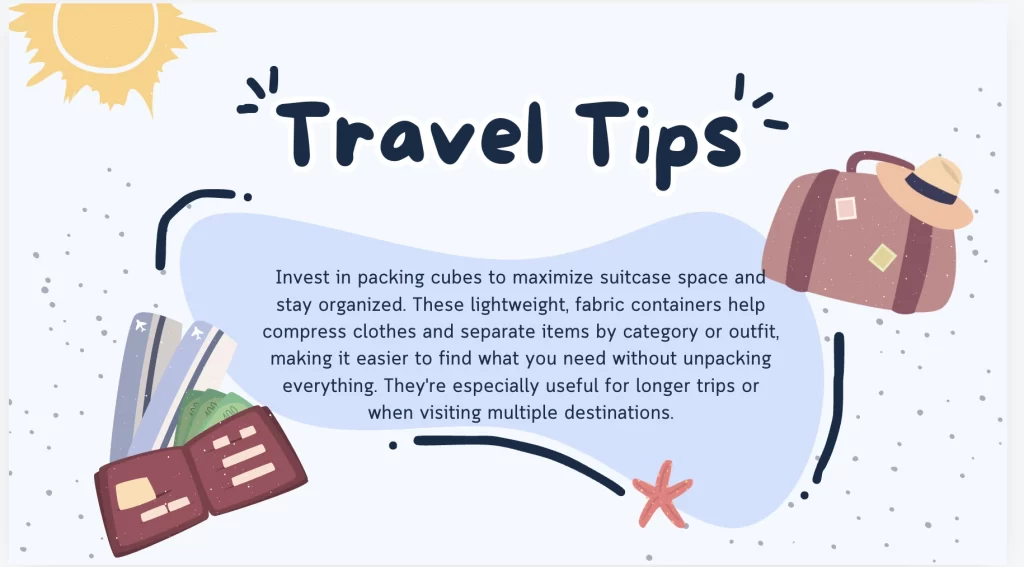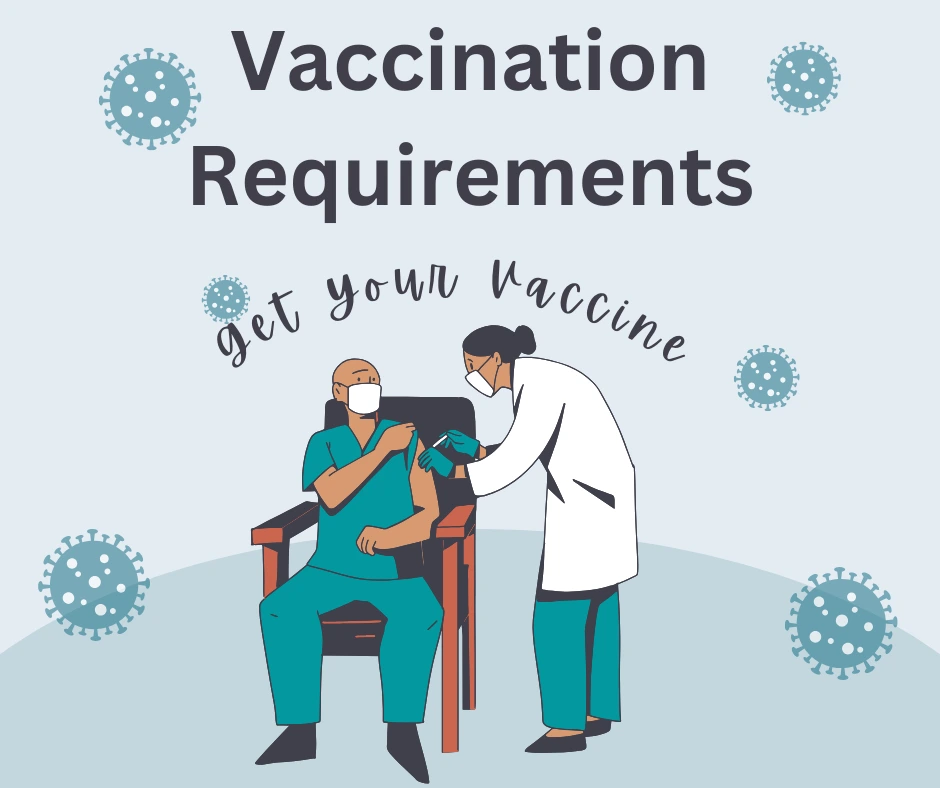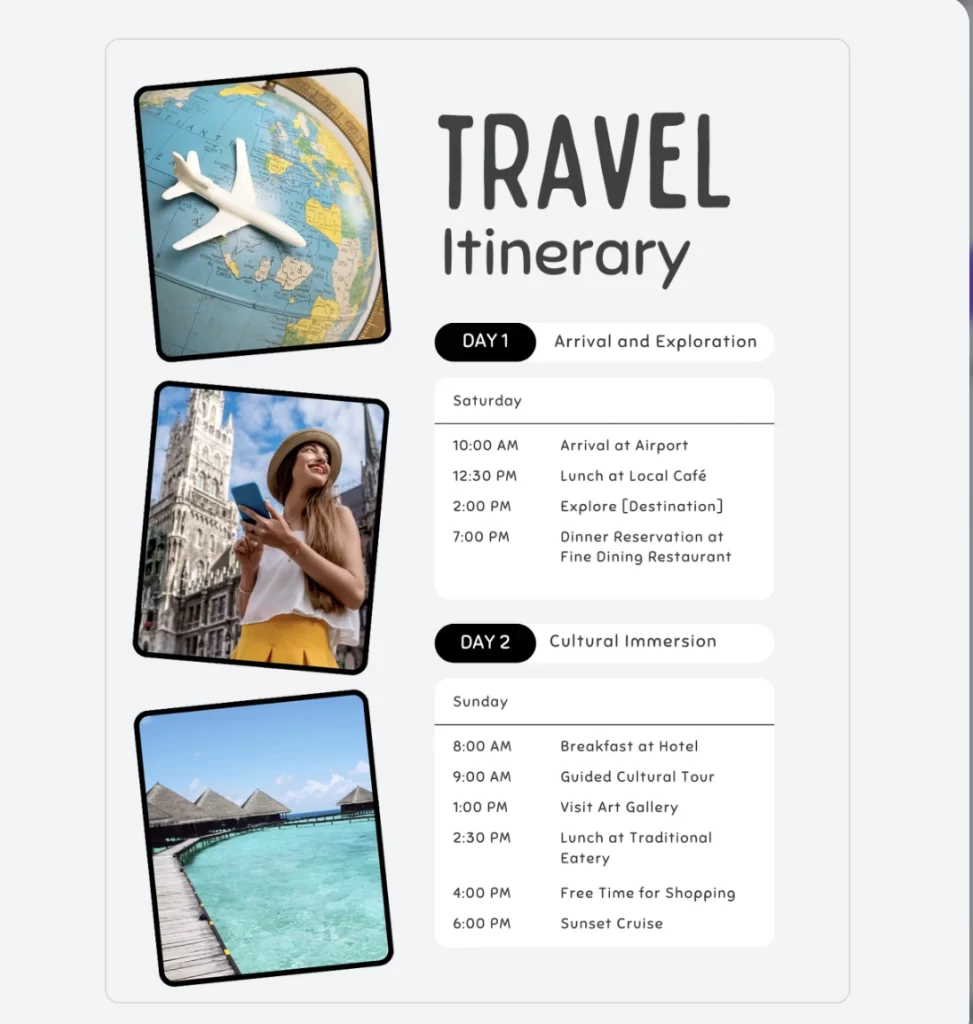Sometimes, the excitement of an upcoming trip can make you forget to do some important tasks. To help you stay organized, here’s a travel checklist before traveling abroad. This list covers everything you need to do from a month before your trip until the day you leave, ensuring you don’t miss anything crucial.
A Month Before Your Trip
1. Make a Packing List
One of the key elements of a travel preparation checklist is to start early. Make your packing list at least a month before your trip. This ensures you won’t forget anything important.
Begin with essential items like clothing, toiletries, travel documents, and medications. Then, move on to non-essential items such as electronics and accessories. Preparing early allows you time to buy anything you’re missing.

2. Research Your Destination
Research local customs and climate so you know what to pack. This will help you avoid overpacking or bringing unnecessary items.
You don’t want to pack several summer clothes, only to find out it’s monsoon season when you land, right?
This is one of the most crucial steps on any travel preparation checklist.
Use a travel planning checklist template to keep everything in check. Templates give you structure and keep you on track, so you don’t forget anything important or pack random items that won’t do you any good.
Do your homework on the culture too. Knowing what’s considered respectful or rude can save you from awkward situations, and even enhance your experience. Simple things like whether you need modest clothing or if tipping is customary go a long way.

So, before you get caught up in the excitement of your trip, take some time to understand your destination. It’s a key step in your pre-travel checklist to ensure you’re ready for anything.
3. Book Your Accommodation
The earlier you book your hotel or Airbnb, the better. Prices typically rise as your trip approaches. If you plan on renting a car abroad, now is the time to apply for an international driver’s permit. It can take weeks to process, so start early.

4. Check Vaccination Requirements
Some countries require specific vaccinations for entry. Check if you need any and schedule an appointment to get them. Make sure to do this well in advance to avoid last-minute panic.
you show up without the required vaccinations, you could be denied entry, quarantined, or worse, put yourself at risk of serious illness. No one wants to deal with that kind of headache when trying to enjoy a vacation.

So, do yourself a favor and check the vaccination requirements as soon as you book your trip. Some vaccines, like yellow fever or hepatitis, are required for certain regions, and others are just a smart move depending on where you’re going.
Once you know what’s required, schedule an appointment with your doctor or a travel clinic. Keep in mind, that some vaccinations need time to take effect or might require multiple doses over a period of weeks. This is why you need to do this well in advance—adding it to your travel preparation checklist is a no-brainer.
Don’t wait until the last minute, because finding out you need a vaccine right before your trip will only cause panic and unnecessary stress. And while you’re at it, make sure you get an international vaccination card (like the “yellow card”), which proves you’ve been vaccinated. This is often required when entering certain countries.
Getting the right vaccines protects you and others, so don’t overlook this crucial step in your checklist before traveling abroad. It’s simple but could save you from a whole lot of trouble down the road.
Do you need travel vaccine requirements by country? Here is a table I always use to check the vaccination I would need before my travel date. It summarizes the strict vaccination requirements for the listed countries, including the United States and Europe’s (general requirements):
| Country/Region | Required Vaccinations | Recommended Vaccinations |
| Ghana | Yellow Fever (for all travelers over 9 months) | Hepatitis A, Typhoid, Meningitis, routine vaccines. Consider Hepatitis B, Rabies, and Malaria prophylaxis. |
| Brazil | Yellow Fever (for travelers from specific countries or visiting certain areas) | Hepatitis A, Typhoid, routine vaccines. Consider Hepatitis B, Rabies, and Malaria prophylaxis for certain areas. |
| India | None for most travelers. Yellow Fever if coming from an infected area | Hepatitis A, routine vaccines. Consider Hepatitis B, Rabies, Typhoid. |
| Saudi Arabia | Meningococcal vaccine (quadrivalent) for Hajj and Umrah pilgrims. Polio vaccine for some countries | Hepatitis A, routine vaccines. Consider: Hepatitis B, Rabies, Typhoid. |
| Thailand | Yellow Fever if traveling from a country with risk of transmission | Hepatitis A, Typhoid, routine vaccines. Consider Hepatitis B, Japanese Encephalitis, Rabies, Malaria prophylaxis in certain regions. |
| Kenya | Is yellow fever vaccine mandatory for travel to Kenya? Yes,Yellow Fever (for travelers over 1 year old coming from countries with a risk of transmission) is mandatory. | Hepatitis A, Typhoid, routine vaccines. Consider: Malaria prophylaxis, Hepatitis B, Rabies, Meningitis. |
| Uganda | Yellow Fever (for all travelers over 1 year old) | Hepatitis A, Typhoid, Meningitis, routine vaccines. Consider: Malaria prophylaxis, Hepatitis B, Rabies. |
| South Africa | Yellow Fever if traveling from or through a country with risk of transmission | Hepatitis A, Typhoid, routine vaccines. Consider: Hepatitis B, Rabies, Malaria prophylaxis in specific areas. |
| Australia | None (Yellow Fever certificate required if coming from a country with risk of transmission) | Routine vaccines. Consider: Hepatitis A, Hepatitis B, Japanese Encephalitis depending on itinerary. |
| Colombia | Yellow Fever (for travelers visiting areas below 2,300m elevation) | Hepatitis A, Typhoid, routine vaccines. Consider: Hepatitis B, Rabies, Malaria prophylaxis in some regions. |
| United States | None for U.S. citizens or legal residents. Others must show proof of full vaccination against COVID-19 | Routine vaccines. Consider: Hepatitis A, Hepatitis B, Rabies depending on the destination. |
| Europe(General) | Generally none. Some countries may require proof of COVID-19 vaccination or negative test | Routine vaccines, including MMR and seasonal flu. Consider: Hepatitis A, Hepatitis B for some travelers. |
It is also important to note that “Routine vaccines” include MMR (Measles, Mumps, Rubella), DPT (Diphtheria, Pertussis, Tetanus), Polio, and seasonal Influenza.
Remember: Vaccination requirements can change rapidly, especially in response to disease outbreaks or changes in global health situations. Always check with official sources close to your travel date for current information.
5. Review Your Travel Insurance
One essential part of a checklist before traveling abroad is to purchase travel insurance. This covers you in case of emergencies, like illness or accidents, while you’re away.
Here are some key points you should consider when shopping for travel insurance.
- Types of coverage: Look for policies that cover medical emergencies, trip cancellations, lost luggage, and emergency evacuations.
- Destination-specific needs: Ensure coverage is valid for your destination(s) and planned activities (e.g., adventure sports).
- Duration: Match the policy duration to your trip, including departure and return dates.
- Pre-existing conditions: Declare any pre-existing medical conditions; some policies offer coverage for them.
- Cost vs. Benefits: Compare policies from different providers to find the best balance of coverage and cost.
- Policy details: Read the fine print to understand claim procedures, exclusions, and coverage limits.
- 24/7 assistance: Choose a policy that offers round-the-clock emergency assistance.
One Week Before Your Trip
6. Check the Weather and Adjust Your Packing List
A common mistake travelers make is packing for the wrong weather. Check the forecast for your destination a week before departure, and adjust your pre-travel checklist PDF accordingly. If it’s going to be rainy, swap out shorts and flip-flops for more practical gear.
7. Start Packing
Begin by laying out everything you think you need, then cut it down by half. Organize your items into two piles: those you can pack now and those you’ll need until the last minute. Keep items like toiletries and chargers handy until your departure day. Using a travel planning checklist template can help you streamline this process.
8. Notify Your Bank
This is a crucial pre-travel step that you need to keep in mind. Let your bank know you’ll be traveling. They’ll monitor your transactions and prevent your card from being flagged as fraud. There’s nothing more frustrating than having your card declined on vacation, so don’t skip this step in your checklist before leaving on vacation.
Here is a checklist with important points to check with your bank before traveling.
- Timing:
- Notify your bank 1-2 weeks before your trip.
- Some banks allow online travel notices through their website or mobile app.
- For last-minute trips, call your bank’s customer service immediately.
- Multiple cards:
- If you have cards from different banks or credit unions, notify each institution.
- Include both credit and debit cards in your notifications.
- Travel details:
- Provide your exact travel dates, including departure and return.
- List all destinations, including layover countries, even if you’re just passing through.
- If your plans are flexible, give a broader date range to ensure coverage.
- Contact information:
- Ensure your bank has your current phone number and email for urgent communications.
- Consider providing a local contact number at your destination if you have one.
- Card choices:
- Inform the bank which specific cards you plan to use during your trip.
- If you have a rarely-used card you’re planning to take as a backup, make sure to mention it.
- Backup plan:
- Carry at least one secondary payment method (different card network or issuer).
- Consider bringing some cash in the local currency of your destination.
- Look into mobile payment options accepted at your destination (e.g., Apple Pay, Google Pay).
- International fees:
- Inquire about foreign transaction fees on your cards.
- Consider applying for a card with no overseas charges if you travel frequently.
- Ask about currency conversion fees and whether Dynamic Currency Conversion is beneficial.
- ATM access:
- Ask about partner banks or ATM networks abroad for lower or no withdrawal fees.
- Inquire about daily ATM withdrawal limits and consider temporarily increasing them if needed.
- Note any specific instructions for using your card in foreign ATMs.
- Mobile banking:
- Download your bank’s mobile app for easy account monitoring and support.
- Ensure you can log in and use the app before leaving.
- Set up alerts for large transactions or low balances.
- Emergency numbers:
- Save your bank’s international customer service number in your phone and write it down.
- Note the local emergency number for reporting lost or stolen cards in your destination country.
- Consider saving the contact information for the nearest embassy or consulate.
- Card security:
- Review and understand your cards’ liability protection policies for unauthorized charges.
- Know the process for reporting a lost or stolen card while abroad.
- Consider leaving unnecessary cards at home to minimize risk.
- Documentation:
- Make copies of the front and back of your cards (store securely).
- Write down your card numbers and bank contact information; keep separate from your cards.
- Consider using a secure password manager to store this information digitally.
Remember: While many banks have sophisticated fraud detection systems, notifying them of your travel plans adds an extra layer of security and convenience to your trip. It’s always better to over-communicate with your financial institutions before international travel to ensure a smooth and worry-free experience with your finances abroad.
A Few Days Before Your Trip
9. Organize Important Documents
One of the most critical parts of a travel preparation checklist is organizing your travel documents. Ensure your passport, visas, tickets, and insurance are all in one easily accessible place. A travel wallet or document holder is a great investment. Here is a list of must-have travel essentials to include during your travel preparation.
10. Arrange Airport Transportation
If you’re driving, figure out airport parking ahead of time. For longer trips, ask a friend or family member for a ride. If you’re using ridesharing apps like Uber, book a ride in advance.
11. Share Your Itinerary
Share your itinerary and accommodation details with a trusted friend or family member in case of an emergency. This practice creates a vital link between you and home, ensuring someone knows your whereabouts and can act quickly in case of an emergency.

Begin by compiling a comprehensive itinerary that includes your flight details, accommodations, and planned activities. Provide addresses and contact information for each place you’ll be staying, as well as any tour companies or local contacts you’ll be using. If your plans are flexible, share a general outline and commit to updating your contact as your plans evolve.
In addition to your itinerary, share copies of important documents such as your passport, visa, and travel insurance policy. Include any relevant medical information, like allergies or medications you’re taking. This information can be crucial if you need assistance while abroad.
Establish a plan for regular check-ins with your contact. Agree on a method and frequency of communication that works for both of you. This could be daily text messages, emails, or social media updates. Also, decide on a course of action if you miss a scheduled check-in.
While sharing your plans is important, be mindful of privacy. Only share detailed information with trusted individuals and be cautious about posting real-time location updates on social media. Consider using secure cloud storage or specialized travel apps for sharing sensitive information.
Remember, sharing your travel plans isn’t about restricting your freedom—it’s about creating a safety net that allows you to explore with confidence. Knowing that someone back home has your information can provide peace of mind and could be invaluable in an unexpected situation. After your trip, follow up with your contact to let them know
The Day Before Your Trip
12. Charge Your Devices
Make sure all your electronics—from phones to cameras—are fully charged. Pack all your chargers and power banks so you’re ready for the journey.
13. Final Check of Your Packing List
Double-check your things to pack before traveling and ensure you haven’t missed anything. This is your last chance to grab any last-minute items before leaving home.
14. Clean Your House
No one wants to come home to a messy house. Make sure you’ve cleaned up, done laundry, and washed dishes. It’s also wise to empty your fridge and take out the trash to avoid any unpleasant smells.
The Day of Your Trip
15. Pack Last-Minute Essentials
Pack your toiletries, phone charger, and any other items you’ve been using up until now. Keep these items near the top of your bag for easy access during your trip.
16. Triple-Check Your Documents
Check your passport, visas, and tickets one more time before you leave. This part of your checklist before traveling abroad is critical—there’s no such thing as being too careful.
17. Unplug Appliances
Before leaving, unplug any non-essential appliances like your TV, coffee maker, and microwave to save energy and avoid any electrical hazards.
18. Adjust Your Thermostat
Turn down your thermostat to save on heating or cooling costs while you’re away.
19. Grab Your Bags and Head Out!
Now that everything is in order, grab your bags, and get ready to enjoy your trip!
By following this travel preparation checklist, you’ll stay organized and stress-free. Whether you’re heading abroad for a few weeks or just going on a short vacation, this checklist before traveling abroad has you covered. Don’t forget to download our pre-travel checklist PDF to ensure you don’t miss a thing. Safe travels!
















